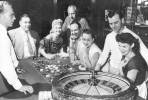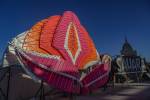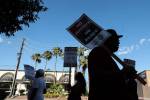Museum’s ‘Lost Vegas’ exhibit pays tribute to imploded properties
What goes up must come down.
Sure, Sir Isaac Newton - the 17th-century British physicist and mathematician - might have figured that out.
But 20th-century Las Vegas perfected it, as the Clark County Museum's current "Lost Vegas" exhibit illustrates.
Focusing on "Bulldozed and Imploded Casinos of the Las Vegas Valley," the exhibition salutes gone-but-not-forgotten properties that once promised the ultimate Vegas vacation.
Using postcards, photographs and artifacts from the now-vanished casinos, "Lost Vegas" introduces - or reintroduces - museum visitors to such Las Vegas legends as the Sands, Desert Inn, Dunes and Stardust, along with smaller but equally memorable properties, notably the off-Strip Moulin Rouge, Las Vegas' first racially integrated casino.
There are quaint reminders of bygone practices, from a vinyl record (baby-faced Wayne Newton's "Live From the Frontier, Las Vegas") to "The Fabulous Oop$tik ," billed as "The Slot Player's Pal," a plastic pole complete with an adhesive tip designed to help gamblers retrieve dropped coins (remember coins?) from the casino floor. (The Hacienda's casino floor, judging by the Oop$tik's gold-embossed logo.)
But some things never change. Consider this postcard, complete with 5 cent stamp, from a long-ago conventioneer: "Having a ball - gained 10 pounds weight, lost 10 pounds from my pocketbook."
The museum display concentrates primarily on Strip properties, in part because downtown casinos "don't implode, they just remodel," explains Dawna Jolliff , the museum's curator of exhibits. "Or they change their names. If you look under Binion's, the Apache Hotel is still underneath."
On the Strip, it's a different story. Some of Las Vegas' most iconic joints have been blasted to smithereens, making way for modern megaresorts.
At the exhibit entrance, video footage recaptures the sights and sounds of the Strip's first major implosions: the 1993 demolition of the Dunes and the 1995 toppling of the Landmark.
The Dunes implosion was featured in a TV infomercial touting the newly built Treasure Island, and the Landmark's toppling played a pivotal role in the 1996 movie "Mars Attacks!"
During the exhibit set-up, Jolliff recalls, she thought about posting a sign over the video monitor with the advisory: "This Will Either Make You Cheer, or Cry."
Jolliff, a Las Vegas native, counts herself in the latter category.
"I can't watch where the Dunes sign went down," she admits.
"Lost Vegas" includes numerous artifacts from the erstwhile home of "a thousand and one delights," including a phone shaped like an athletic shoe and postcards with the Dunes' signature fiberglass sultan - who "couldn't watch the destruction" of the resort "because it had caught fire in 1985 and was not restorable," an exhibit caption says.
The idea for the "Lost Vegas" exhibit began at a planning meeting, when museum administrator Mark Hall-Patton pointed out that " 'we haven't done any casino-related exhibitions in a while,' " recalls Jolliff.
Jolliff then began rummaging through the collections to find items to display.
"Some people might ask, why would a museum collect used keno tickets?" she notes. "But you're collecting history."
After finding hundreds of items, Jolliff winnowed them down, limiting the exhibit to "what is iconic," she explains. For example, "we have tons of swizzle sticks," but only standouts made the cut, including ones featuring the Showboat's namesake paddle-wheeler, the Aladdin's trademark lamp and the Landmark's space-pod tower.
Some contributions from the public also found their way into the exhibition.
A museum visitor who saw "Lost Vegas" returned with a wooden hanger stamped "Wilbur Clark's Desert Inn" - which is now on display alongside other DI mementos, from coffee-shop china to Crystal Room programs featuring Broadway's Bernadette Peters and the tag team of dancer Juliet Prowse and comedian Jan Murray.
"Lost Vegas" spotlights more than souvenirs, however.
One display features chunks of rubble from imploded hotels; a map pinpoints where the rubble wound up: controlling and channeling water through the Las Vegas Wash and Wetlands Park.
And speaking of maps, a 1940s water map locating wells along U.S. Highway 91, the future Las Vegas Boulevard, offers "proof of beneficial use" for El Rancho Vegas, which became the first Strip resort when it opened in 1941.
Today, "the casinos are very different, the atmosphere is very different," Hall-Patton says, noting that the "Lost Vegas" resorts were built on a "more human scale. They needed to pull people off the Strip - when it was the highway."
Strolling through the exhibit, museum visitors can trace the progress of Strip headliners Siegfried & Roy - from the Stardust, where they appeared in "Lido de Paris" before moving to star in "Beyond Belief" at the Frontier.
Trivia nuggets also pop up throughout. Did you know that when the Stardust opened in 1958 touting "Astronomical Luxury at Down-to-Earth Prices", it boasted the largest casino - and the largest swimming pool - in Nevada? Or perhaps you've never heard the rumor that Howard Hughes bought the Silver Slipper (directly across from the Desert Inn, where he had taken over the hotel's top two floors) in part because he thought there was a camera in the toe of the casino's giant, light-bedecked high heel, which rotated until Hughes bought the place - and stopped the Slipper's slipper from twirling.
From the Rat Pack's "Summit at the Sands" - when Frank Sinatra, Dean Martin, Sammy Davis Jr. and pals held court in the Copa Room - to less-starry outposts (Castaways, anyone?), "Lost Vegas" finds room for them all.
And, somehow, museum visitors are finding them too. Originally set to end Aug. 26, "Lost Vegas" has been extended through December, proving that all those casinos live on in the memories of those who recall, to quote one Sands postcard, "the spirit of Las Vegas."
Contact reporter Carol Cling at ccling@reviewjournal.com or 702-383-0272.
Preview
"Lost Vegas: Bulldozed and Imploded Casinos of the Las Vegas Valley
9 a.m.-4:30 p.m. daily, through December
Clark County Museum, 1830 S. Boulder Highway, Henderson
$2 general, $1 ages 3-17 and 55 and over; free through Labor Day for active-duty military and families (455-7955)





























